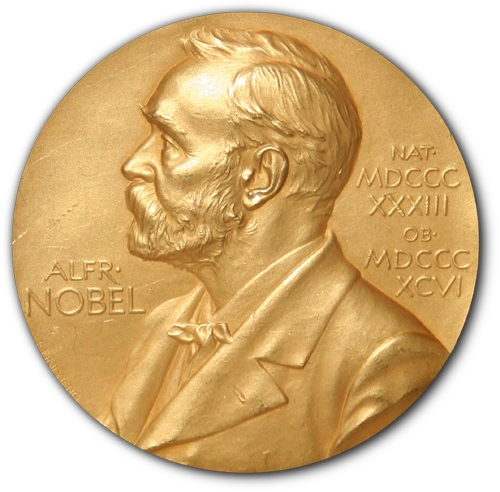Dissolving Medals

During World War II, Adolf Hitler prohibited the export of gold from Germany. But gold, being valuable in small amounts and not easily traced, is very difficult to regulate. (Indeed, that is probably where its true value comes from.) Hitler’s edict was in almost all cases, unenforceable.
One exception? Nobel Prize medals.
Before 1980, the medals given by Sweden (which is all except the Nobel Peace Prize — that is awarded by Norway) were made of 600 grams of 23-karat gold — and therefore subject to Hitler’s export ban. The recipient’s name was engraved on the back of the medal, making it clear to anyone at anything more than a casual glance. This proved uniquely dangerous for two physics laureates, Max von Laue (winner, 1914) and James Franck (1925), both Germans. When World War II began, the two entrusted the Bohr Institute, in Copenhagen, Denmark (the research institution of fellow physics laureate Neils Bohr) with the safe keeping of their medals, assuming that Nazi soldiers would have otherwise confiscated their prizes. When Nazi troops invaded Denmark, the also raided the Institute. Had von Laue’s and Franck’s medals been discovered, the consequences were most likely dire.
Enter Hungarian chemist George de Hevesy, a future Nobel Laureate himself (in Chemistry). He, Jewish, had gone to the Institute looking for — and temporarily at least, finding — safe haven from the Nazis. He and Bohr decided that more standard ways of hiding the medals (e.g. burying them) would not suffice, as the risk of harm to von Laue and Franck was too great to chance the medal’s discovery. The chemist de Hevesy took more drastic action. He created a solution of aqua regia — a concoction consisting typically one part nitric acid to three parts hydrochloric acid, which is so named because it can dissolve two of the “royal” metals, gold and platinum. (Wikipedia explains how, for those with a sizable understanding of chemistry.) He then left the gold-bearing aqua regia solution on his laboratory shelf within the Institute, hidden in plain sight as Nazi stormtroopers ransacked the Institute.
The plan worked, and von Laue and Franck were safe — as were their awards. The gold remained safely on that shelf, suspended in aqua regia, for the remainder of the war, unnoticed by the German soldiers. When the war ended, de Hevesy precipitated the gold out of the solution, and the Nobel committee recast the medals.
Bonus fact: Throughout human history (through 2009, at least), mankind has successfully mined roughly 165,000 metric tons of gold. At gold’s density, that comes out to about 300,000 cubic feet — a relatively tiny-sized amount. For comparison’s sake, all the gold ever mined could be contained by the New York Public Library’s Rose Reading Room (seen here), which has a volume of approximately 1.2 million cubic feet.
From the Archives: Marathon Madness: A different type of gold medal, but crazy nonetheless — the story of the marathon at the 1904 Summer Olympics.
Related: One can buy gold nuggets on Amazon, but as the lone reviewer notes, the product is more accurately described as “dust.” Perhaps you should opt for the uraniuminstead? (Yes, uranium.)

Leave a comment